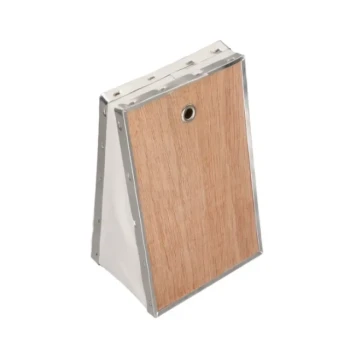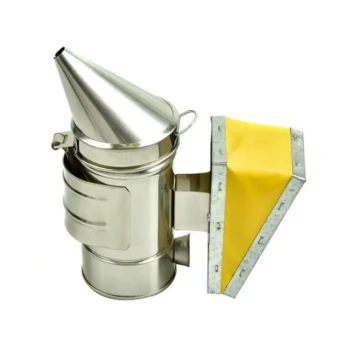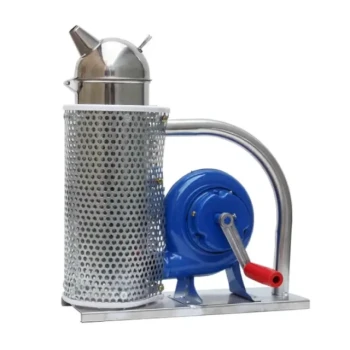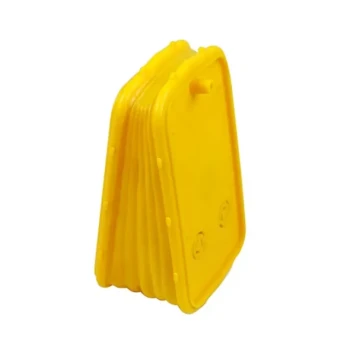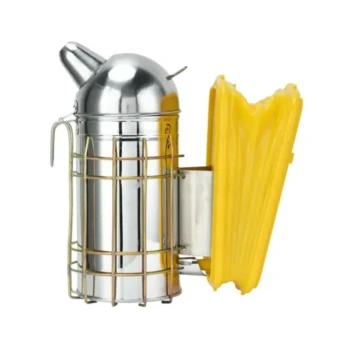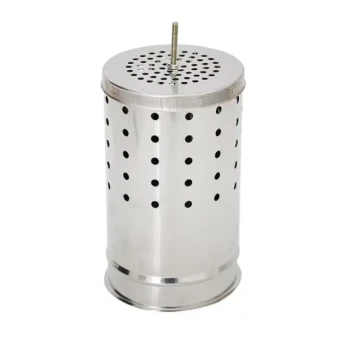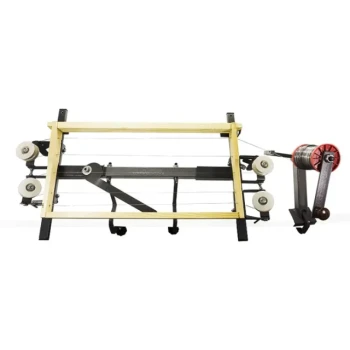In short, the best bee hive smoker fuel is one that is natural, untreated, burns slowly, and produces a thick, cool, white smoke. While many materials work, beekeepers widely favor dried pine needles, untreated wood pellets, and staghorn sumac bobs for their consistency and safety for the bees.
The goal is not simply to create smoke, but to produce the right kind of smoke—cool, gentle, and free of toxins. Therefore, the "best" fuel is less about a single material and more about choosing a substance that is safe for your bees, readily available to you, and easy to keep lit.

The Principles of an Ideal Smoker Fuel
To select the right fuel, you must first understand what you are trying to achieve. The smoke calms bees by masking the alarm pheromones they release, not by incapacitating them.
Produces Cool, White Smoke
Hot, black, or acrid smoke can alarm and harm your bees. The ideal fuel smolders slowly, producing a cool, dense, white smoke that is gentle on the bees and effectively masks their communication.
Long-Burning and Consistent
A fuel that burns out quickly requires constant relighting during a hive inspection. A good fuel source will smolder consistently for 20-30 minutes or more, allowing you to focus on the hive.
Non-Toxic and Natural
This is the most critical principle. Your smoker delivers smoke directly into the bees' home. Any fuel containing chemicals, pesticides, glues, or plastics can introduce toxins that will harm or kill the colony.
Readily Available and Cost-Effective
The best fuel is often one you can source for free from your own environment. Practicality matters, and a sustainable, easily accessible fuel source makes your job as a beekeeper easier.
Evaluating Common Smoker Fuels
Different fuels have different characteristics. What works best often depends on your local environment and what you can easily source.
The Gold Standard: Natural & Foraged Fuels
These are often considered the best options because they are free, effective, and align with natural beekeeping principles.
- Pine Needles: Dry pine needles are a favorite. They are easy to light, smolder well, and produce a pleasant-smelling, gentle smoke.
- Staghorn Sumac Bobs: The fuzzy, red fruit clusters of the staghorn sumac are an excellent, long-burning fuel.
- Dried Grasses & Leaves: Dry, crumbled leaves or balled-up clumps of dry grass work well, but may burn more quickly than denser materials.
Processed & Commercial Options
For those who value convenience and predictability, commercially available fuels are a reliable choice.
- Wood Pellets: Pellets made for pellet stoves or BBQ smokers are excellent. They are dense, burn for a very long time, and produce consistent smoke. Always ensure they are 100% natural hardwood with no chemical additives.
- Cotton Scraps: Balled-up scraps of all-cotton fabric (like old jeans) or untreated cotton baling twine are long-burning and reliable.
Understanding the Trade-offs and Pitfalls
Choosing the wrong fuel can be frustrating for you and dangerous for your bees. Avoiding common mistakes is as important as finding the right material.
The Danger of Chemical Contaminants
Never use materials that have been chemically treated. This includes pressure-treated lumber, painted or varnished wood scraps, and cardboard or paper with glossy inks or heavy glues. These can release toxic fumes.
The Problem with Poorly Burning Fuels
Some materials, like loose grass clippings or very fine sawdust, pack too tightly and can smother the fire, causing it to go out repeatedly. This makes inspections difficult and frustrating.
Why Green or Damp Materials Fail
Never use green leaves, fresh grass, or damp wood. These materials produce a great deal of steam and acrid smoke instead of the cool, white smoke you need. This will irritate the bees rather than calm them.
Choosing the Right Fuel for Your Apiary
Your choice will depend on your priorities as a beekeeper. Use these guidelines to make a decision.
- If your primary focus is bee health and sustainability: Use foraged, untreated natural materials like dry pine needles, staghorn sumac, or dried leaves from your property.
- If your primary focus is convenience and reliability: Use commercial, 100% natural wood pellets or dedicated cotton-based smoker fuels.
- If your primary focus is minimizing cost: Look for safe, free materials in your local environment, such as dried grasses, untreated cotton twine, or pine cones.
Ultimately, the right fuel ensures a calm and safe experience for both you and your bees.
Summary Table:
| Fuel Type | Key Characteristics | Best For |
|---|---|---|
| Pine Needles | Easy to light, pleasant smell, gentle smoke | Foraging, sustainability |
| Wood Pellets | Long-burning, dense, consistent smoke | Convenience, reliability |
| Staghorn Sumac | Excellent long-burning properties | Natural beekeeping |
| Cotton Scraps | Reliable, long-burning | Cost-effectiveness |
Ensure your apiary's success with the right equipment. HONESTBEE supplies durable, high-quality beekeeping supplies and equipment to commercial apiaries and distributors through our wholesale-focused operations. Let us help you build a more productive and efficient operation. Contact our team today to discuss your needs and request a wholesale catalog!
Visual Guide
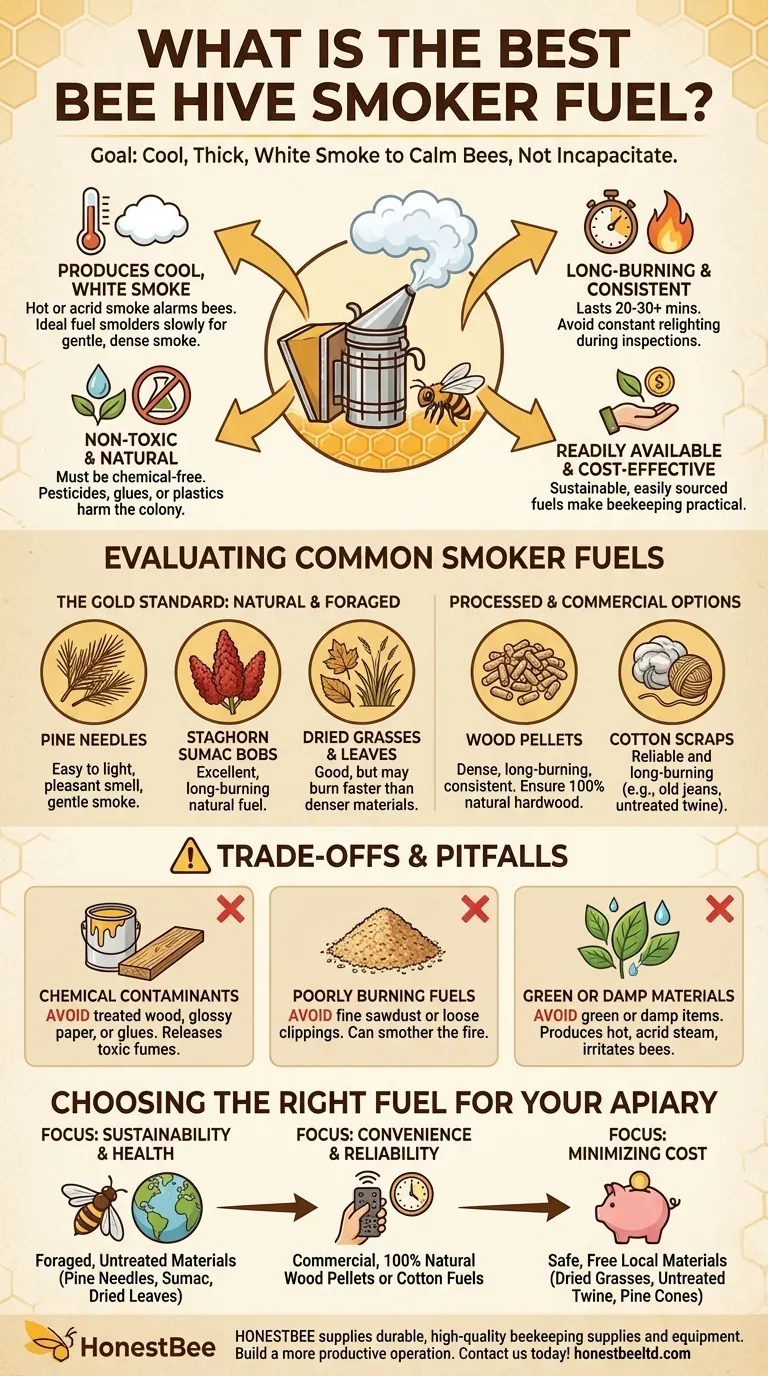
Related Products
- 54-Piece Smoker Fuel Pellets for Beekeeping Beehive Smoker Fuel
- Stainless Steel Honey Bee Smoker Hive and Honeycomb Smoker for Beekeeping
- European Stainless Steel Bee Smoker for Honey Bee Hive
- Economy Galvanized Beekeeping Honey Bee Smoker for Wholesale
- Professional Bee Smoker with Elongated Spout and Durable Bellows for Beekeeping
People Also Ask
- What is best to burn in a bee smoker? Master the Layered Fuel Technique for Calm Hives
- What are important considerations when choosing smoker fuel? A Guide to Safe, Effective Beekeeping
- What is used in a bee smoker? Master the Best Fuels for Calm, Healthy Hives
- How should you start the fire in a bee smoker? A Step-by-Step Guide for a Calm Hive
- What to put in a bee hive smoker? A Guide to Natural, Calming Fuels








